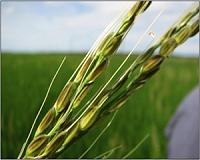 |
Washington DC (SPX) Nov 11, 2010 U.S. Department of Agriculture (USDA) scientists in West Virginia are finding ways to improve soil on degraded land so it can be used for sports fields and other uses. Researchers with USDA's Agricultural Research Service (ARS) at the agency's Appalachian Farming Systems Research Center (AFSRC) in Beaver, W.Va., are developing constructed or replacement subsoils and topsoils to build better and less-costly sports fields, raingardens and lawns on former landfills, mine lands and other degraded land. ARS is USDA's principal intramural scientific research agency. The constructed soil research project is in its fourth year. ARS is conducting the research in cooperation with the National Turfgrass Research Initiative, Inc., a joint turfgrass industry-ARS program created in 2007. The initiative draws on the expertise of scientists with ARS and at universities, according to lead scientist Rich Zobel at AFSRC. The turfgrass industry has set a high priority on improving degraded soils by constructing soils that include readily available rural, urban and industrial byproducts that can be mixed with local soils. These byproduct mixes are being tailored to not only reduce rain runoff and erosion, but also to remove or neutralize pollutants before they reach storm drains. With lower costs through using inexpensive local byproducts, schools and local parks have a better chance of being able to afford soil replacement for better turfgrass survival. Eliminating compacted soil is the first step toward growing good, robust grass. The most promising mixture so far includes quarry byproducts and composted chicken litter. It has met predetermined requirements such as the ability to transmit stormwater. Zobel and his colleagues develop recipes for constructing designer soils from various materials in Ohio, Kentucky, Tennessee, West Virginia, Virginia and southern Pennsylvania. For the future, Zobel envisions new turfgrass varieties, possibly perennial ryegrass and tall fescue, that will penetrate compacted soil and renovate fields without the need to tear up fields and till compacted soil. Read more about this research in the November/December 2010 issue of Agricultural Research magazine.
Share This Article With Planet Earth
Related Links U.S. Department of Agriculture (USDA) Farming Today - Suppliers and Technology
 Study launched to boost rice production
Study launched to boost rice productionHanoi, Vietnam (UPI) Nov 10, 2010 A $600 million global scheme to boost rice yields was announced in Hanoi Wednesday. Launched by the International Rice Research Institute and the Consultative Group on International Agricultural Research, the Global Rice Science Partnership is expected to lift 150 million people out of poverty by 2035 and prevent the emission of greenhouse gases by an amount equal to 1 billion tons of c ... read more |
|
| The content herein, unless otherwise known to be public domain, are Copyright 1995-2010 - SpaceDaily. AFP and UPI Wire Stories are copyright Agence France-Presse and United Press International. ESA Portal Reports are copyright European Space Agency. All NASA sourced material is public domain. Additional copyrights may apply in whole or part to other bona fide parties. Advertising does not imply endorsement,agreement or approval of any opinions, statements or information provided by SpaceDaily on any Web page published or hosted by SpaceDaily. Privacy Statement |